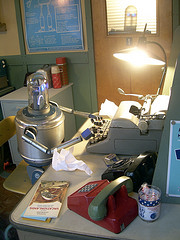 Will digital content lose the human touch?
Will digital content lose the human touch?
The forces of automation and the non-stop demand for more and more content may be leading us in a direction where the robot writers take over. That would be a sad day for the humans they put out of work, so let’s hope it’s not so.
“In practice, “robot writers” – with varying levels of sophistication and autonomy – are beginning to be installed, discreetly, by a few media and other business sectors that generate large volumes of written documents,” The Guardian[i] reported last year.
The Associated Press, for example, now relies on automation for some 3,000 stories per quarter, primarily to generate rapid distribution of company earnings reports[ii].
Those AP reports are generated by Automated Insights’ Wordsmith platform. That platform “transforms Big Data into narrative reports by spotting patterns, correlations and key insights in the data and then describing them in plain English, just like a human would, [iii]” the company claims.
 According to the Guardian report, Forbes now published content generated by Narrative Science. That company uses the Quill natural language generation platform to develop narratives that it claims are “indistinguishable from what a human would write.[iv]”
According to the Guardian report, Forbes now published content generated by Narrative Science. That company uses the Quill natural language generation platform to develop narratives that it claims are “indistinguishable from what a human would write.[iv]”
And, says an article in The New York Times, “These robo-writers don’t just regurgitate data, either; they create human-sounding stories in whatever voice — from staid to sassy — befits the intended audience…And when you read the output, you’d never guess the writer doesn’t have a heartbeat.[v]” An accompanying quiz[vi] offers you the opportunity to test your skills at discerning the human touch from that of the computer.
Add those capabilities to marketing automation platforms and, voila, there goes the human neighborhood, right?
Maybe so, but Raul Valdes-Perez argues in a Tech Crunch article that robot writers will emerge slowly. “The main reason is that writers need to find something to say that is worth reading, whether that something is routine or consists of novel insights of lesser or greater generality,[vii]” he writes. Computers can indeed cover the range from routine event summaries all the way up to novel discovery, but each competency requires work, and there’s no magic bullet, nor magic touchscreen.”
Yes it may be possible in the near future, if it isn’t already happening, to automate the production of digital content, even crafted and individualized to specific targets. But there’s still a need to connect in a one-to-one, human interaction.
B2B decision makers are already overwhelmed by content, so the ability to automatically generate additional content may rapidly bump up against the law of diminishing returns.
Steve Peck of Docalytics recently previewed research data on B2B content consumption in a “teaser” blog at content marketing specialists
Influence & Co. He provides three “eye opening stats” on reader engagement:
- B2B decision makers have short attention spans — “the average reader viewed a resource for two minutes and two seconds and only consumed 53 percent of an average content offer.[viii]”
- Most content is way too long – “the average e-book, whitepaper, or guide was a whopping 13 pages from cover to cover.”
- Returning visitors are the minority – “Seventy-two percent of prospects downloading your content haven’t previously downloaded content from your website.”
Taking marketing automation to task in an article at Contently.com last year, Justin Lambert warned that “too heavy a reliance on marketing automation in lieu of the kind of best practices that actually make it work properly can do a lot of damage to your content marketing strategy.[ix]” Content consumers, he argued, “need to believe you’re working with their best interests in mind, that you care about them as individuals, and that what you have to say means something important to them personally.”
Maybe the algorithms driving robot writers will reach that point some day; maybe not. In the meantime, B2B prospecting still requires identifying and cultivating high-potential leads. As we’ve previously discussed, technology exists to facilitate and enhance our capabilities, but we must take care to not let it determine how we interact with buyers.
Here at SimplyDIRECT we offer our clients Gatepoint Research services involving prospect surveys and custom research reports that form the basis of insightful, human-generated content for targeted inbound and outbound marketing campaigns.
[i] http://www.theguardian.com/technology/2014/sep/12/artificial-intelligence-data-journalism-media
[ii] http://www.theverge.com/2015/1/29/7939067/ap-journalism-automation-robots-financial-reporting
[iii] http://automatedinsights.com/wordsmith/
[iv] http://www.narrativescience.com/
[v] http://www.nytimes.com/2015/03/08/opinion/sunday/if-an-algorithm-wrote-this-how-would-you-even-know.html?_r=0
[vi] http://www.nytimes.com/interactive/2015/03/08/opinion/sunday/algorithm-human-quiz.html?_r=0
[vii] http://techcrunch.com/2015/06/27/robot-writers-need-something-to-say/
[viii] http://blog.influenceandco.com/3-eye-opening-stats-on-b2b-content-consumption
[ix] http://contently.com/strategist/2014/07/21/i-robot-how-marketing-automation-can-destroy-your-content-marketing-strategy/
